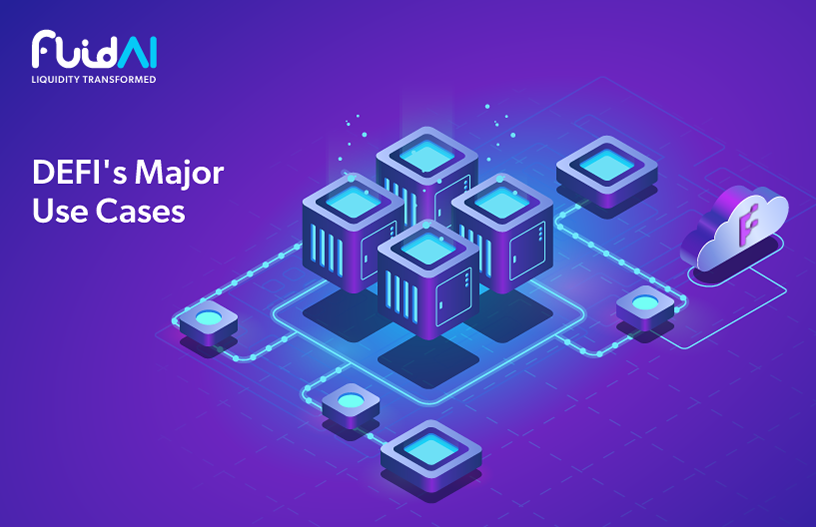Imperial College London and FluidAI Announce Groundbreaking AI Partnership! Read here 🤝

Major Use Cases in DeFi
The DeFi industry has the potential to disrupt the TradFi industry by using blockchain-based applications and services to replicate banking, investing, and trading activities. Many TradFi services already have a DeFi counterpart, and more are on the way.

Major Use Cases in DeFi
Key Takeways
- Since 2020, decentralized finance (DeFi) has grown exponentially
- More than $11 billion has been invested in Ethereum DeFi systems, with over 100,000 users
- The most prevalent use-cases include open lending systems, decentralized exchanges, and digital asset staking, although new tools and platforms emerge regularly
- While many DeFi sites offer real value to customers, there are also a lot of scams. It’s always recommended to conduct some research before working with DeFi protocols
The DeFi industry has the potential to disrupt the TradFi industry by using blockchain-based applications and services to replicate banking, investing, and trading activities. Many TradFi services already have a DeFi counterpart, and more are on the way.
A DeFi platform is likely to provide any financial instrument or service, whether it be insurance, exchanges, or staking solutions. However, not all DeFi systems have been thoroughly verified or vetted by other parties, and many remain experimental. Because financial losses might occur in some situations, this should be considered before dealing with any DeFi platform.
This article will go over some of the most common DeFi use cases in order to provide an understanding of the rapidly changing DeFi environment. The DeFi concept is being applied in many verticals every day, and listed below are some of the top use-cases of DeFi.
Major DeFi Use-cases
Borrowing and Lending: The most extensively practiced use cases of the DeFi ecosystem are peer-to-peer borrowing and lending. DeFi allows users to borrow money without having to fill out an application or having a bank account. The borrower does not need to locate a lender in certain DeFi applications; instead, the smart contract functions as a lender, and interest is computed based on supply and demand.
In several other DeFi applications, the loans come with a set interest rate. DeFi makes the loan and borrowing procedure considerably simpler and time-saving.
Stablecoins
Another important use case of DeFi is stablecoins, which are cryptocurrencies that are designed to maintain a stable value relative to a fiat currency, such as the US dollar. Stablecoins are essential for DeFi applications because they provide a stable unit of account and a medium of exchange that can be used for transactions and investments.
There are several types of stablecoins in the DeFi space, including fiat-backed stablecoins, algorithmic stablecoins, and collateralized stablecoins. Some of the most popular stablecoins include USDT, USDC, DAI, and BUSD.
Insurance
Because DeFi is still in its early stages, there are hazards associated with smart contract issues and breaches. A slew of new insurance options have emerged to help with liability reduction, DeFi overage reduction, and property preservation.
Synthetic Assets
Synthetic assets are crypto-assets that offer exposure to other assets like gold, cryptocurrencies, and fiat money. These synthetic assets are collateralized by tokens which are locked into Ethereum-based smart contracts which comprise built-in agreements and incentives. DeFi promises to combine all different smart contracts easily.
Decentralized exchanges (DEXs)
One of the most prominent use cases of DeFi is decentralized exchanges, or DEXs, which allow users to trade cryptocurrencies in a decentralized, trustless, and transparent manner. DEXs use smart contracts to facilitate trades, eliminating the need for intermediaries like centralized exchanges. As a result, DEXs offer several benefits over traditional exchanges, including increased security, privacy, and control over assets.
Some of the most popular DEXs in the DeFi space include Uniswap, SushiSwap, and Curve. These platforms enable users to trade a wide range of cryptocurrencies with minimal fees and no need for KYC/AML compliance.
Tokenization
Tokens are digital assets created, issued, and managed on a blockchain network that is designed for secure and instant transfer. Tokenization is a native function of the Ethereum blockchain and is a cornerstone of decentralized finance. These tokens are the fuel for the network and also unlock various economic possibilities.
These tokens are digital alternatives for users to access, trade, and store value across the globe.
Analytics & Risk Management
Decentralization and transparency paved the way for all users to discover and analyze a massive quantity of data. Users may make well-informed business decisions because of this data access, uncover new financial possibilities, as well as employ the most effective risk management strategies.
This development has resulted in new data analytics with blockchain tools and dashboards, and DeFi initiatives like DeFi Pulse or CoDeFi Data provide an astonishing amount of value with analytics and risk management tools.
Because firms have grown more agile, this will have the greatest influence on DeFi use cases.
Liquidity Provision
Liquidity provision is defined as serving as a middleman by trading in and out of relatively short-term holdings on a regular basis. Liquidity providers often issue orders to the market at prices that reflect available knowledge about asset pricing, as well as the risk of transacting and holding that asset. Liquidity providers are distinguished by the fact that they provide liquidity at all times, not just when they want to amass or close down longer-term investment holdings.
In today’s markets, liquidity providers must be diverse in order to ease risk transfer and efficiently match buyers and sellers during continuous trading.
Infrastructure Tooling
Composability is a feature in the DeFi ecosystem that works as a basic infrastructure development protocol for connecting and interoperating system components. The infrastructure tools are significant DeFi use cases since DeFi projects are interconnected through a network effect.
Digital Identification
Blockchain-based digital identity systems have gained a lot of support in recent days, and combining DeFi protocols with this makes global economic system access much easier.
Digital identity, financial activity, and professional skills are all important in DeFi.
This upgraded digital identity can allow users to access data from any location with an internet connection. This is one of the DeFi’s possible applications.
Complying with AML & CFT
KYC guidelines contradict the privacy efforts of DeFi. DeFi solves this with a new concept known as the Know-Your-Transaction (KYT) mechanism, which focuses on transactional behaviors.
This KYT solves two issues at a time – monitoring real-time transactional behavior and ensuring the privacy of users. This makes KYT a major player in decentralized finance use cases.
Savings
Due to the high pace of inflation and low-interest rates in fiat currencies, it often becomes difficult to save money, which is why risk-averse people all over the world are frantically looking for new ways to invest and save.
Various decentralized finance (DeFi) projects have taken the chance to propose innovative solutions. With their no-loss savings philosophy, projects like PoolTogether, Dharma, and Argent are showing potential.
Payment Solutions
Serving the unbanked or underbanked from the beginning was a key impetus for DeFi. Today, DeFi’s intrinsic characteristics make it well-suited to addressing the problems with today’s global payment systems. In comparison to traditional systems, DeFi provides faster, safer, and more transparent alternatives.
DeFi-based blockchain in payment solutions may appeal to the unbanked population since it eliminates the need for middlemen, making payments easier and more transparent.
Decentralized Autonomous Organizations (or DAOs)
In DeFi, DAOs are the centralized financial institutions’ equivalent, making them one of the foundations of DeFi use-cases.
Decentralized organizations were developed by the Ethereum blockchain ecosystem to service all financial processes such as fundraising, asset management, governance, and so on.
Apart from the above fields, DeFi finds applications in all businesses to make decentralized finance. Payments, analytics, trading, wallets, education, and more are some of the various DeFi use-cases.
FLUID’s DeFi Solution
DeFi is a rapidly growing area of blockchain technology that offers several innovative use cases that have the potential to revolutionize traditional finance. From decentralized exchanges to stablecoins, lending and borrowing platforms, yield farming, and decentralized insurance, DeFi is transforming the financial landscape and offering users greater control, transparency, and security over their assets.
FLUID LP is a trustless, secure, compliance practitioner, transparent, permissionless, cross-chain swapping tool and pool to earn solutions, offering deep liquidity. FLUID LP utilities include:
- The possibility to transfer assets from one chain to another with FLUID’s Swapping tool
- Possibility to participate in revenue generated by FLUID LP and $FLD rewards as
- Stable Liquidity Partners (SLP): Cross-chain stablecoin liquidity provider (option reserved for FLUID) partners pooling stablecoin reserves for a longer period of time and rewarded a fee)
- FLUID stakers: Anyone interested in buying and staking the $FLD token that can be accessed through two solutions: FLUID Revenue Recycling Pools (RRP) and FLUID Fee Reduction Pools (FRP)
- FLUID Liquidity Pools: Users stake any token and are rewarded with a percentage of $FLD
- FLUID Lend by borrowing stablecoin (P2P) using $FLD as collateral or lend $FLD to earn APY
The FLUID team is aiming to develop and introduce a minimal viable product to enable synth-free, cross-chain stablecoin transfers as soon as possible. The minimal viable product of FLUID LP will enable performing transfers of selected stablecoins from one chain to another.
FLUID’s vision is to enable truly integrated and seamless exchange between all CEX and DEX platforms that need cross-chain swapping. FLUID identified this opportunity and is building a valuable tool that will benefit all users. There are plenty of users looking for better ways to carry out simple asset transfers across chains today.
To read more about FLUID LP’s key features, refer to the litepaper here.
Conclusion
It’s no wonder that DeFi has a strong position in the global economic ecosystem, given the surge in the sheer quantity of DeFi initiatives and application cases. Not only does DeFi provide realistic alternatives, it also creates new marketplaces and trade opportunities. In addition, DeFi has the power to outperform older systems and technology in every aspect.
On the other hand, DeFi continues to face a lot of obstacles and hurdles. Users continue to be hesitant to accept new techniques and practices owing to mistrust and a lack of information. Furthermore, statistics show that 63.2 percent of the world’s population lacks internet access, implying that over one-third of the world’s population does not have access to DeFi.
As with all things crypto, FLUID heavily advises on due diligence before interacting with any DeFi platform and protocol.













